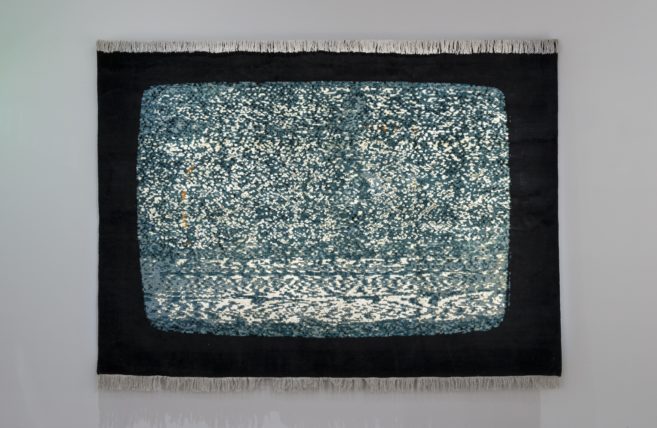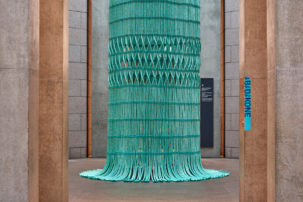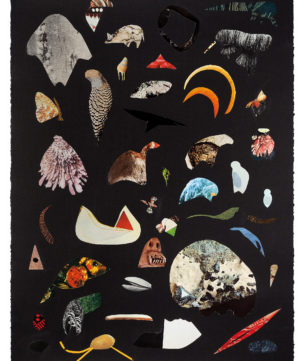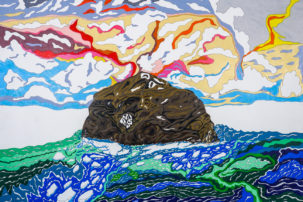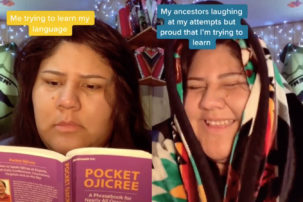Imagine, a few months ago, entering the Great Hall of the Metropolitan Museum of Art: you are flanked by a Hellenistic Greek sculpture to the left and an ancient Egyptian statue to the right; a large gift shop is tucked away in one corner; there is a membership information desk; and the loud voices of schoolchildren mix in cacophony with the classical live violin playing in the restaurant above. Infographics adorn the walls and kiosks point you in the direction of wondrous collections and exhibitions. This information hub is not an easy space to view art.
In December 2019, two monumental paintings by Cree artist Kent Monkman were unveiled on either side of the Met’s central interior entrance. mistikôsiwak (Wooden Boat People) is grandiose, provocative, even monstrous. When I visited the Met prior to its COVID-19 closure, I was surprised that these paintings were largely ignored by visitors coordinating ticket pick-ups. I saw some folks seated on the benches look up briefly between Instagram scrolling sessions, catching the painting in their eye, examining it and then continuing to scroll. I saw a few folks stop to look up at the paintings and read the small labels next to them, then look up at the paintings again and move on. The chaos of the Great Hall generally ushers folks to continue moving. I was astonished that even those in line to check their coats, who stood below the paintings, did not take time to look at the art above them.
The reality of contemporary Indigenous art in large-scale art museums like the Met is that most people do not come to see Kent Monkman; they come to see the arms and armour wing, the Temple of Dendur overlooking Central Park, or the Costume Institute’s designer exhibitions. Within the past three years, museums throughout New York have been hosting contemporary Indigenous art exhibitions with praise and acclaim—the usual suspects are cisgender Indigenous men, like Monkman, who are not typically indigenous to the area, but brought in from more “successful” Indigenous contemporary art communities. The current conversation about Indigenous representation in institutions is one of panic and urgency because of the historic underrepresentation of Indigenous artists in galleries and museums. But on opening night, the Great Hall was filled with Indigenous artists, spectators and curators. The clout-carrying population of contemporary art and Indigenous representation were there to praise Miss Chief Eagle Testickle for her performance work and Kent Monkman for his artwork. It was a celebration.
The shared-history narrative proposes multiculturalism and increased representation as reparations, and conflates colonialism as a wrongdoing of the past when it is in fact a system of the present. …Our traumas are not “shared”; our histories are not “shared.”
The day before the unveiling of mistikôsiwak (Wooden Boat People), the Met published a text by Met curator Randall Griffey, titled “Kent Monkman Reverses Art History’s Colonial Gaze,” in which he states that Monkman’s pieces “highlight the Museum as both a byproduct and beneficiary of colonizing forces, and illuminate how encyclopedic art museums perpetuate settler perspectives of history.” What Griffey fails to unpack in this account is how the Met, like so many other institutions, is not willing to navigate the complexities of settler colonialism as an ongoing practice; rather, it brushes off criticism of the gallery’s occupation of Indigenous territories under the guise of “our shared history.” Even within Griffey’s framing, Monkman’s paintings do little to question art-historical inequalities between settlers and Indigenous peoples, and pander to the erasure of Indigenous sovereignty through the narrative of a shared history between settlers and colonizers as though their experiences are commensurate. The shared-history narrative proposes multiculturalism and increased representation as reparations, and conflates colonialism as a wrongdoing of the past when it is in fact a system of the present. It also absolves institutions of their participation in the system of colonialism, and continues the erasure of genocide and its legacy by offering a mythology of shared pain and struggle with settlers. Our traumas are not “shared”; our histories are not “shared.”
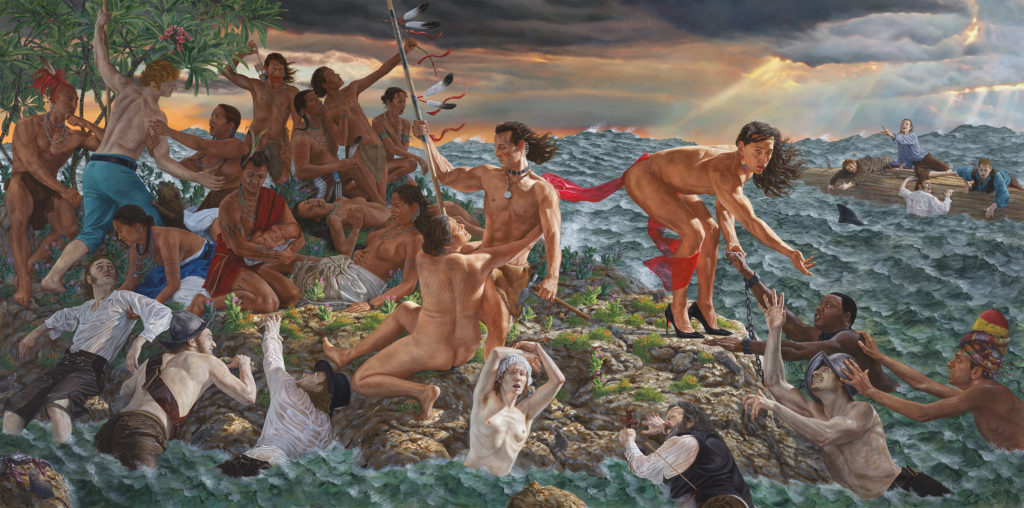 Kent Monkman, Welcoming the Newcomers, 2019. Acrylic on canvas, 3.3 x 6.7 m. Courtesy Metropolitan Museum of Art. Photo: Joseph Hartman.
Kent Monkman, Welcoming the Newcomers, 2019. Acrylic on canvas, 3.3 x 6.7 m. Courtesy Metropolitan Museum of Art. Photo: Joseph Hartman.
The installation comprises two acrylic 11-by-22-foot paintings: Welcoming the Newcomers and Resurgence of the People (both 2019). Each is a hyperrealistic depiction of interactions with settlers in both past and present. Welcoming the Newcomers is a historical satire in which we witness a number of conversations. The focus is a rock island covered in lichen, with Monkman’s alter ego, Miss Chief Eagle Testickle, standing on the edge, her hand outstretched to survivors of an unknown nautical disaster. She is wearing beaded earrings and Louboutin heels, and a silky scarf is entangled around her body, caught in the wind. Though her hand is outstretched, her gaze is to the viewer and her attention is broken, allowing the viewer to catch a glimpse of her tears and mascara-stained cheek. One of her hands is holding a shackled enslaved person, and the other reaches out to help another person of colour submerged in the ocean waves. Surrounding her is chaos: European settlers cling to the rocks. Some are being helped by Indigenous folks, others are ignored. One man holding a cross has been shot with an arrow.
On the horizon, where the light is beginning to break from behind the clouds, settlers cry for help, their bodies and the surrounding debris punctured with arrows, while a shark circles them menacingly. On the island are multiple scenes of Indigenous life, including a birthing ceremony, teachings of how to shoot a bow and arrow, and imagery of Indigenous kinship and violence. The most striking scene, to me, is of a settler grasping at the breast of an Indigenous woman. Her face is in terror and pain, yet she seems to be pulling him closer. Climbing up this settler’s pant leg is a beaver, the crux of the plot. The beaver trade was what brought French settlers to Indigenous shores and led to the outpour of capitalist violence. Behind the settler is an Indigenous man, lost in thought, witnessing the violence.
This small, almost hidden moment of violence in such a large, complex painting harkens to contemporary violence against Indigenous women and femmes perpetrated by white men and witnessed by Indigenous men. Amid the work’s many narratives, this small moment of violence echoes legacies of sexual violence justified throughout capitalist-fuelled colonialism. Whether portraying Indigenous strength or violence against Indigenous peoples, Welcoming the Newcomers is an elegant mishmash of genocidal trauma and cultural resistance. Monkman has stated that he wanted to include elements of Indigenous history and refute themes of disappearance. The viewer can here witness the historical through an Indigenous lens, and watch the arrival of European settlers, enslaved folks and other marginalized people of colour to the rocky shores of Monkman’s imagination.
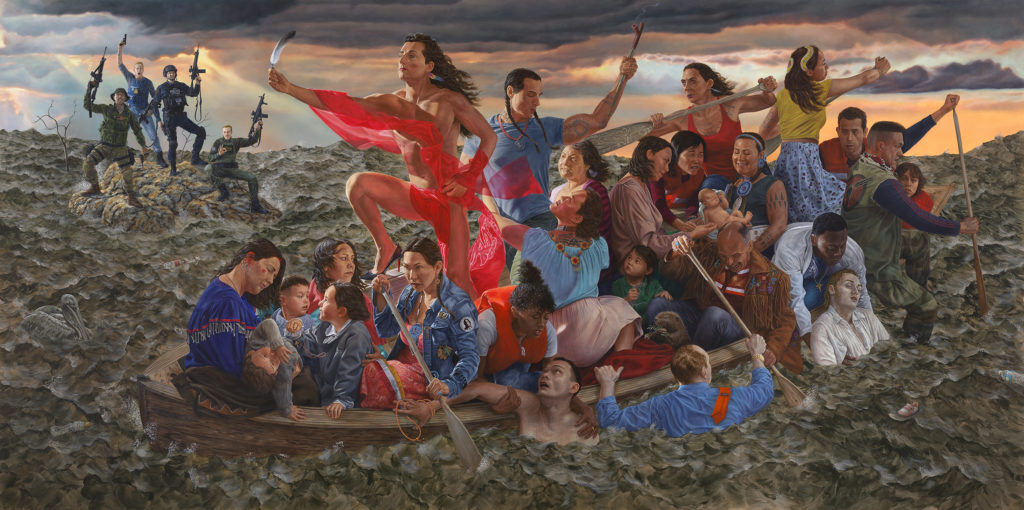 Kent Monkman, Resurgence of the People, 2019. Acrylic on canvas, 3.3 x 6.7 m. Courtesy Metropolitan Museum of Art. Photo: Joseph Hartman.
Kent Monkman, Resurgence of the People, 2019. Acrylic on canvas, 3.3 x 6.7 m. Courtesy Metropolitan Museum of Art. Photo: Joseph Hartman.
Resurgence of the People picks up where Welcoming the Newcomers leaves off. Situated in contemporary times, Resurgence of the People is a snapshot of what Indigenous folks are witnessing and experiencing today. Monkman describes Resurgence of the People as being in conversation with “arrivals and migrations and displacements of people around the world” and portraying Indigenous generosity. In the boat with canoe paddles, we see different types of people, including settlers, non-white migrants, as well as Black and Brown people. Resurgence of the People introduces the theme of migratory agency in which the demographic has changed to reflect the diversity of the Canadian settler state. The painting is based on Emanuel Leutze’s 1851 painting Washington Crossing the Delaware, which depicts General George Washington’s crossing of the Delaware River with the Continental Army on the night of December 25, 1776, during the American Revolutionary War. Leutze’s painting, which is on display in the American Wing of the Met, is a fantastical representation of the cross-section of the people within the American colonies. Included in this rendering is a man wearing a Scottish bonnet, a man of African descent and an Indigenous person in the rear of the boat, along with a number of white men. Washington Crossing the Delaware was meant to represent the idea that all the people within the boat were necessary for the victory over the British, and therefore necessary for America’s multicultural utopia.
Monkman’s retelling depicts Miss Chief Eagle Testickle commanding the boat. She is the focal point yet again, wrapped in the same red fabric, same Louboutin heels and same beaded earrings. Her arm is outstretched. She has an eagle feather in hand as the boat moves forward, ignoring the island occupied by military and police personnel. Monkman is depicting Miss Chief Eagle Testickle leading the resurgence of the people, leading a return to languages and traditions. Monkman chose to copy Leutze’s classical format, which consists of a frieze-like arrangement that culminates in a main grouping around Miss Chief Eagle Testickle, with the feather forming the apex.
On the boat are some of the same Indigenous people who posed for Welcoming the Newcomers, and some of the scenes are similar: a birth is taking place and people are being rescued from the now toxic and polluted waves. We see children, mothers, matriarchs, Two-Spirit kin and non-Indigenous people, including Black folks who are pulling survivors onto the boat. The Indigenous people on the boat are dressed in amalgamations of traditional and colonial fashion, and their tattoos, jewellery and accoutrements remain unapologetically Indigenous. Toward the back of the boat is an Indigenous man in army fatigues emblazoned with the Idle No More logo—a fist holding a feather—on the back. (Idle No More is a grassroots movement born of the passing of Bill C-45, which overhauled the Navigable Waters Protection Act, or NWPA, of 1882. Repealing this act meant that the settler colonial government of Canada was no longer mandated to perform extensive approval and consultation processes before construction of any kind around waterways.)
Tucked in the middle of the boat is a beaver, reminding viewers of the origin of this inhumane and unjust colonial world. In the water, there are floating plastic bottles (Nestle and Coca-Cola come to mind), which bring to the fore discussions of the continued environmental destruction through global colonialism and capitalist enterprise. A pelican, dirtied by pollution, bobs alongside the detritus.
What I found distressing, and important, about Resurgence of the People was the small rocky island inhabited solely by military, RCMP and weaponized white supremacists. All are holding their guns in the air and jeering at the passing boat. These men are a constant reminder of continued police violence against Indigenous people. They are the personification of the settler state and the genocidal violence perpetrated under the flags of democracy. On the didactics and exhibition texts and in the programming associated with mistikôsiwak (Wooden Boat People), the Met has neglectfully chosen not to explain this part of the painting. Considering the very visible police violence against the Wet’suwet’en people during the span of this exhibition, the Met missed an opportunity to discuss the ongoing police violence perpetrated against Indigenous peoples under settler colonial occupation. Militarized police personnel represent a real threat to Indigenous life, on and off the canvas. The Met carefully compared the other figures in the painting to works within their own collection, and likened Monkman’s work to a masterful European painting canon. Why then is this island left untouched and undiscussed?
Certainly, Monkman’s paintings are in conversation with both Indigenous folks and white settlers; however, I found myself wondering who Monkman’s works are shared with—who is the intended spectator of his work?
Monkman’s narrative paintings leave the eye delighted and exhausted, and demand painstaking attention to detail to truly and fully unpack the messages delicately and strategically intertwined within. Resurgence of the People is both celebration and horror; it demands of the viewer a complete commitment to a visual orchestra of trauma and resilience, through the perspective of Indigenous sovereignty. Certainly, Monkman’s paintings are in conversation with both Indigenous folks and white settlers; however, I found myself wondering who Monkman’s works are shared with—who is the intended spectator of his work?
As a queer Indigenous femme, I do not call on a shared history with white people for strength and empathy, but rather the shared and unshared histories of marginalized folks—most important, Black people. Recognizing kinship is a form of agreement. Although Monkman’s work is meant to “reverse art history’s colonial gaze,” it in fact perpetuates it by pandering to a white spectatorship and focusing on relationship building between settlers and Indigenous communities. These paintings are made for a predominantly white audience, presented in an institution historically composed of white cultural workers and displayed in harmony with, rather than in contradiction of, a colonial institution. Monkman’s work participates in continuing narratives of “the other” (narratives that are highly visible within the Met’s collection) and therefore adopts the colonial gaze he attempts to work against.
On February 7, 2020, in solidarity with the Wet’suwet’en people and land defenders, the Indigenous Kinship Collective staged a sit-in action at the Met in front of mistikôsiwak (Wooden Boat People), underneath Resurgence of the People. Our intention was to draw attention to the irony of settler institutions commissioning work about relationship building with Indigenous peoples despite continued settler colonial violence in Wet’suwet’en. We chanted, “You want our art, but not our people. You want our land, but not our people.” We chose to sit underneath Resurgence of the People to acknowledge that the Met had not referenced the military and police presence in the painting in either the didactics or public engagement for the show, and to ask for an explanation as to why, especially in light of the police violence in Wet’suwet’en territories. Why not use the Met’s global platform to stand against continued police and settler violence by expressly explaining Monkman’s choice to depict police and militarized personnel in his painting? The omission of an account of that choice was a disservice to the Indigenous peoples currently embroiled in violent conflict with the militarized forces of settler colonial nations. Such neglectful actions—like those that stem from representing Indigenous peoples in galleries like the Met while refusing to fully politically support Indigenous communities—placate white supremacy and continued police state violence against Indigenous people. It should come as no surprise then that four femme Indigenous people were violently ousted from the Met during the Indigenous Kinship Collective’s action. I was dragged to the ground by an undercover police officer and detained until leaving the museum. The Indigenous Kinship Collective confronted the Met with the uncomfortable truth that representation politics do not address the ongoing violence that all settler colonial institutions are still complicit in, including the criminalization and policing of Indigenous peoples.

